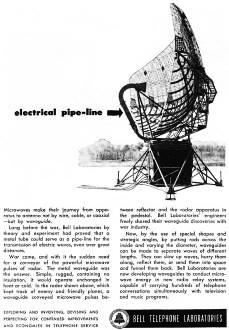Bell Telephone Laboratories: Electrical Pipe-Line
|
||||||
Once World War II was over, a flood of technical information poured out of government, academic, and corporate research and manufacturing institutions. Making available such data was a promise made by the Department of War to a citizenry which largely supported the wartime effort to maximize resource usage for defeating Axis powers. People and businesses provided raw and recyclable materials as well as services in the interest of assuring our fighting men had every tool at their disposal while fighting for the folks back home. To today's unpatriotic and selfish population it might seem like a Pollyanna and even unlikely view of the world, but that was the case back in the day. Bell Telephone Laboratories (aka Bell Labs) contributed Big League (not "bigly," as ignoramuses claim Trump said) to the pushing forward of technical frontiers. A major development was use of waveguide for microwave systems like radar. As mentioned in this 1947 Popular Mechanics magazine infomercial, their engineers had already figured out how to not only transport radio frequency signals within the confines of waveguide, but also how to effect filters and other functions with them. Bell Labs produced many such promotions in many different magazines over the decades (see list below). Bell Telephone Laboratories Ad: Electrical Pipe-Line
Long before the war, Bell Laboratories by theory and experiment had proved that a metal tube could serve as a pipe-line for the transmission of electric waves, even over great distances. War came, and with it the sudden need for a conveyor of the powerful microwave pulses of radar. The metal waveguide was the answer. Simple, rugged, containing no insulation, it would operate unchanged in heat or cold. In the radar shown above, which kept track of enemy and friendly planes, a waveguide conveyed microwave pulses between reflector and the radar apparatus in the pedestal. Bell Laboratories' engineers freely shared their waveguide discoveries with war industry. Now, by the use of special shapes and strategic angles, by putting rods across the inside and varying the diameter, waveguides can be made to separate waves of different lengths. They can slow up waves, hurry them along, reflect them, or send them into space and funnel them back. Bell Laboratories are now developing waveguides to conduct microwave energy in new radio relay systems, capable of carrying hundreds of telephone conversations simultaneously with television and music programs. Exploring and Inventing, Devising and Perfecting for Continued Improvements and Economies in Telephone Service Bell Telephone Laboratories
Posted February 21, 2024
|
||||||

